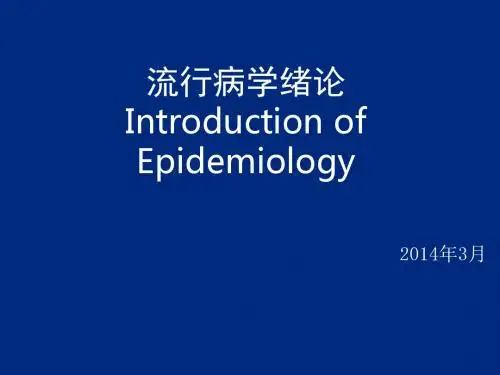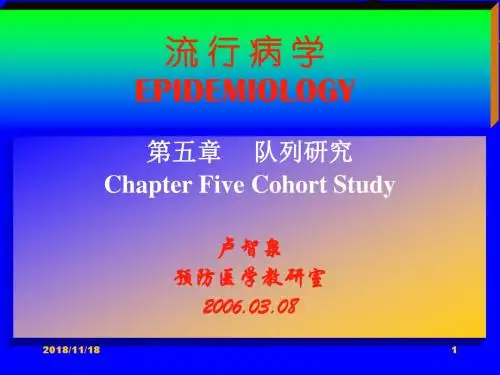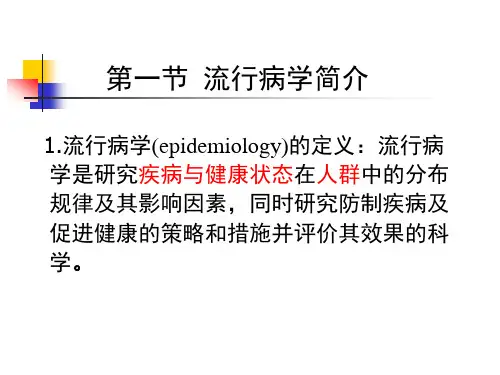流行病学课件 1 Introduction_
- 格式:pdf
- 大小:1008.37 KB
- 文档页数:67



流行病学EPIDEMIOLOGY第五章队列研究Chapter Five Cohort Study卢智泉预防医学教研室2006.03.08第五章队列研究Chapter Five Cohort Study•队列研究 Cohort study 亦称前瞻性研究prospective study,与病例对照研究方法同属分析性流行病学研究中两种重要的方法,广泛地用来探索疾病的危险因素,检验病因假设。
使用这种方法可以直接观察人群暴露于病因的情况及其结局,从而确定危险因素与疾病的关系,在验证假设上是一种介于病例对照研究与人群试验之间的一种研究方法。
本研究方法可在描述性流行病学工作基础上,初步形成病因假设之后,或经病例对照研究初步检验了病因假设之后,再进一步确证该假设的正确性。
•一、基本概念 Basic principle• A study design in which a population cohort is prospectively defined and divided according to the presence or absence of an exposure variable of interest and then followed over time for the occurrence of prespecified outcomes.• A type of study in which investigators begin with a group of subjects without the disease of interest (eg, lung cancer), classify them according to their exposure status (eg, people who smoke a pack of cigarettes a day compared with people who do not smoke), then monitor them over time for subsequent disease development; this is also called a follow-up study.•所谓队列是指具有共同经历,共同暴露于某一种因素或共同具有某一特征的人群。








流行病学(第9版)PPT课件-第一章-绪论1. 简介本PPT课件为流行病学第9版的第一章绪论的内容概述,主要介绍了流行病学的定义、发展历程和学科领域,以及流行病学的重要性和应用。
通过本章的学习,可以帮助同学们全面了解流行病学的基本概念和研究方法。
2. 流行病学的定义2.1 流行病学的概念流行病学是研究人群中疾病发生、发展和分布规律的科学。
它通过采集和分析大量的疾病数据,进而揭示疾病的发病原因、危险因素和控制策略,从而为公共卫生实践提供科学依据。
2.2 流行病学的发展历程流行病学起源于18世纪的英国,最初只是为了研究传染病的流行规律。
随着科学技术的进步和研究方法的改进,流行病学逐渐发展为一门独立的学科,并应用于各种疾病的研究与防控工作中。
2.3 流行病学的学科领域流行病学研究的领域包括:流行病学法、环境流行病学、职业病流行病学、分子流行病学、生物统计流行病学等,涉及到医学、生物学、统计学等多个学科领域。
3. 流行病学的重要性3.1 预防疾病流行病学的研究可以揭示疾病的发病原因、危险因素和传播途径,为疾病的预防和控制提供科学依据。
通过制定有效的预防策略,可以减少人群中疾病的发生率和死亡率,提高人群的健康水平。
3.2 制定医疗政策流行病学的研究结果可以为制定医疗政策提供科学依据。
通过研究不同疾病的流行趋势和影响因素,政府和卫生部门可以合理规划医疗资源,提高医疗服务的效率和质量。
3.3 评估干预措施的效果流行病学的研究可以评估不同干预措施对疾病发展的影响。
通过比较不同干预措施的效果,可以找到最有效的控制策略,提高干预措施的可行性和可持续性。
3.4 提供健康教育流行病学的研究结果可以作为健康教育的科学依据。
通过向公众普及疾病的发病原因和预防措施,可以提高广大群众的健康意识和健康行为,减少疾病的发生和传播。
4. 流行病学的应用4.1 疾病监测和预警流行病学的方法可以用于疾病的监测和预警。
通过监测疾病的流行趋势和分布情况,可以及时预警和控制疾病的扩散,减少疾病对人类健康的危害。